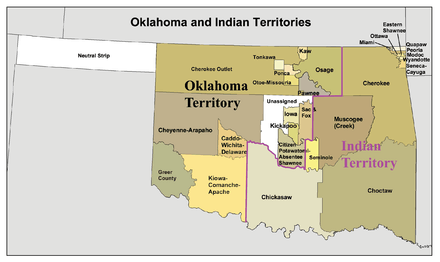State of Sequoyah
| State of Sequoyah | |
|---|---|
|
The State Seal | |
|
Proposed State of Sequoyah | |
| Constitutional convention: | August 21, 1905 |
| Convention President: | Pleasant Porter |
| Vice President(s) |
William C. Rogers, Cherokee |
| Statehood | |
|
Approved 1905 by referendum. Denied by United States Congress. Became part of State of Oklahoma in 1907. | |
The State of Sequoyah was a proposed state to be established from the Indian Territory in the eastern part of present-day Oklahoma. In 1905, with the end of tribal governments looming (as prescribed by the Curtis Act of 1898),[1] Native Americans of the Five Civilized Tribes—the Cherokee, Chickasaw, Choctaw, Creek (Muscogee), and Seminole—in Indian Territory proposed to create a state as a means to retain control of their lands. Their intention was to have a state under Native American constitution and governance.[2] The proposed state was to be named in honor of Sequoyah, the Cherokee who created a writing system in 1825 for the Cherokee language.
Background

From 1890, when Congress passed the Oklahoma Organic Act, the land that now forms the State of Oklahoma was made up of two separate territories: Oklahoma Territory to the west, and the Indian Territory to the east. The Indian Territory had a large Native American population. The territory had been reduced by required land cessions after the Civil War; land runs; and through other treaties with the United States. In the 1900 US Census, Native Americans composed 13.4 percent of the population in the future state. In 1905, the Five Civilized Tribes had a total of about 60,000 persons in the Indian Territory out of a total population of 600,000.[3]
Until 1903 the Five Civilized Tribes and other tribes in Indian Territory had generally opposed all local and national efforts for statehood, whether single or joint with Oklahoma Territory. This changed as the date set by Congress (March 4, 1906) for the break-up of tribal governments and communal lands in the territory approached. The desire tribal leaders to retain their historic authority and for the territory to be admitted as a single state (apart from Oklahoma Territory) culminated at the Sequoyah Convention, which met as a whole August 21 and 22 and September 5 through 8, 1905.[1]
The constitutional convention
The Sequoyah Constitutional Convention met in Muskogee, on August 21, 1905. General Pleasant Porter, Principal Chief of the Creek Nation, was selected as president of the convention. The elected delegates decided that the executive officers of the Five Civilized Tribes would also be appointed as vice-presidents: William C. Rogers, Principal Chief of the Cherokees; William H. Murray, appointed by Chickasaw Governor Douglas H. Johnston to represent the Chickasaws; Chief Green McCurtain of the Choctaws; Chief John Brown of the Seminoles; and Charles N. Haskell, selected to represent the Creeks (as General Porter had been elected President). Muscogee journalist Alexander Posey served as secretary.[4]
The convention drafted a constitution, drew up a plan of organization for the government, put together a map showing the counties to be established, and elected delegates to go to the United States Congress to petition for statehood. On November 7, 1905, voters in the territory approved the constitution and statehood petition by a vote of 56,279 to 9,073.[1]
Failure to obtain statehood
Territorial leaders realized that the Republican-led Congress was unlikely to admit the heavily Democratic Indian Territory into the Union. Yet, early in the 59th Congress, Representative Arthur P. Murphy of Missouri and Senator Porter J. McCumber of North Dakota introduced Sequoyah statehood bills, which were defeated.[1] President Theodore Roosevelt then proposed a compromise that would join Indian Territory with Oklahoma Territory to form a single state. This resulted in passage of the Oklahoma Enabling Act, which he signed June 16, 1906.[5][6] Oklahoma became the 46th state on November 16, 1907.[7]
Although the State of Sequoyah never came into existence, its constitution made an important contribution to Oklahoma history. It had many similarities to the later Oklahoma Constitution, sharing an underlying populist distrust of elected officials. The convention also catapulted Haskell, Murray, and others further into the public arena, securing for Indian Territory a solid seat at the debate to come later at the Oklahoma Constitutional Convention.[1]
See also
- Cherokee Commission
- Former Indian reservations in Oklahoma
- Hitchcock County, Sequoyah
- Pushmataha County, Sequoyah
References
- 1 2 3 4 5 Mize, Richard (2009). "Sequoyah Convention". Oklahoma Historical Society. Retrieved May 10, 2016.
- ↑ "Museum of the Red River - The Choctaw". Museum of the Red River. 2005. Retrieved 4 August 2009.
- ↑ "THE STATE OF "SEQUOYAH."" (PDF). The New York Times (Archive). 5 October 1905. Retrieved 4 August 2009.
- ↑ Wilson, Linda D. "Posey, Alexander Lawrence (1873—1908)," Encyclopedia of Oklahoma History and Culture, 2009. Accessed March 1, 2015.
- ↑ "Enabling Act 1906". Chickasaw History & Culture. Chickasaw.TV.
- ↑ Everett, Dianna. "Enabling Act (1906)". Encyclopedia of Oklahoma History and Culture. Retrieved January 10, 2012.
- ↑ "Today in History: November 16". loc.gov. Library of Congress.
External links
- Large map showing the Oklahoma and Indian Territories in 1895
- Oklahoma Digital Maps: Digital Collections of Oklahoma and Indian Territory
Coordinates: 35°00′N 95°30′W / 35.0°N 95.5°W

